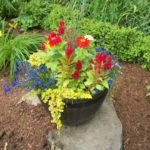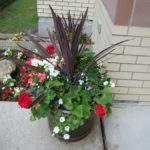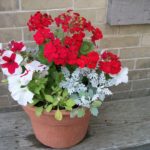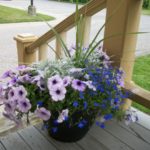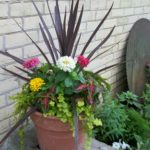by Angela Lassam
It’s Still Just Dirt, The Tillsonburg News – August 2017
We all know about aphids especially on roses, the slugs on hostas, and the tent caterpillars that are very noticeable on the trees this time of year. But what do we really know about Japanese beetles?
The Japanese beetle, as the name implies, originated in Japan and was first detected in the U.S. in 1916, and has since become a big nuisance for the gardener and horticulturalist. It is a big problem in the Niagara farming belt. It is a colourful beetle with a metallic green head and copper hard shelled body only measuring ½” but is very destructive. It does not discriminate on what it eats – just about anything leafy, fruit leaves, vegetables, ornamentals and even weeds.
Their life cycle starts mid-summer as eggs dropped into any open soil. Then as grubs they eat any roots and go deep into the soil for the winter. The following year as soon as the soil warms up they rise to the surface devouring all roots in their path and mature to the Japanese beetle.
As soon as it gets warm and sunny you will see the beetles flying around. It is said that a ‘scout’ beetle will precede a swarm and they will continue to invade your garden everywhere. This will last up to six weeks and is the time you will see the skeletal destruction on large leaves. They only survive one generation but they are very prolific laying many eggs.
When they are grubs moles will eat them underground. Raccoons and skunks will dig them up for food and the bigger birds will pick them up.
There are a few methods to control them. Early in the season you can actually pick them off plants into a bucket of water and dispose later. They are sleepy at this time and also they do not see well which helps us catch them. The normal insecticidal soap will work but needs to be repeated often.
A home-made solution of soap, water, garlic powder and cayenne pepper applied with a garden sprayer will leave a gross taste as a good deterrent but also a tedious daily chore.
There are beetle traps available at any nursery which will catch them easily. They work on the principle of a pad with pheromones on it which will attract them and a bag attached below it to catch them. They fly into a plastic fin (remember they do not have good eyes) and drop into the bag. Empty the bag daily. The trap needs to be hung away from all vegetation to be effective.
There is new information which shows that geraniums have a toxic effect on the Japanese beetle. Many were found dead underneath some plants suggesting this to be true.
I hope that many of you have taken the time to admire the gardens in town tended by the Horticultural Society volunteers. They can be seen outside the Senior Centre at the Community Complex. A colourful sight is outside the Livingstone Centre. The Station Arts Centre is a popular place to visit as we’ll as the market that is there on Saturday. Many events happen at the Royal Canadian Legion especially for the 150th Anniversary. Annandale House was one of the venues on Canada Day and the gardens have had a rejuvenation there. Woodingford Lodge is an ongoing challenge but the residents and visitors enjoy beautiful gardens there. Library Lane has also been added recently to this list of locations. On a final note the large urns everywhere and the smaller ones outside businesses downtown have added colour and life to our town.
Regular monthly meetings will resume on Tuesday Sept 5th @ 7.30 pm in the Senior Centre Auditorium, Tillsonburg Community Complex. Speaker for this meeting will be Mitchell Hewson, Registered Horticultural Therapist.The topic is Power of Nature – living healthy using remedies through horticulture. Members remember this meeting is the Grow and Show Flower Competition. Non-members are welcome with a $2 per meeting or become a member and get extra benefits.
For further information check out www.tillsonburghorticultural.ca or on Facebook – tillsonburghorticultural.
Take a minute to look at these photographs of the beautiful urns at Annandale National Historic Site where Horticultural Society members design, plant and nurture the gardens each year.
